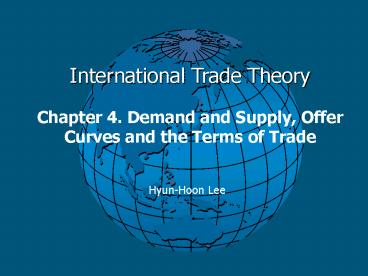Mankiw 5e Chapter 1: The Science of Macroeconomics - PowerPoint PPT Presentation
1 / 17
Title:
Mankiw 5e Chapter 1: The Science of Macroeconomics
Description:
International Trade Theory. Chapter 4. Demand and Supply, Offer Curves and the Terms of Trade ... To examine the effect of international trade on the earning of ... – PowerPoint PPT presentation
Number of Views:243
Avg rating:3.0/5.0
Title: Mankiw 5e Chapter 1: The Science of Macroeconomics
1
International Trade Theory Chapter 4. Demand and
Supply, Offer Curves and the Terms of Trade
- Hyun-Hoon Lee
2
OUTLINE
- 4.1 Introduction
- 4.2 The Equilibrium-Relative Commodity Price
with Trade-Partial Equilibrium Analysis (Skip) - 4.3 Offer Curves
- 4.4 The Equilibrium-Relative Commodity Price
with Trade-General Equilibrium Analysis - 4.5 Relationship between General and Partial
Equilibrium Analyses (Skip) - 4.6 The Terms of Trade
3
4.1 Introduction
- Chapter 3 showed
- a difference in relative commodity prices between
two nations in isolation is a reflection of their
comparative advantage and - with trade, the equilibrium-relative commodity
price is determined somewhere between the
autarkic relative prices. - Chapter 4 presents a more rigorous theoretical
way of determining the equilibrium-relative
commodity price with trade. - 4.2 Partial Equilibrium Analysis (Skip)
- 4.3-4.4 General Equilibrium Analysis
4
4.2 The Equilibrium-Relative Commodity Price with
Trade-Partial Equilibrium Analysis
- Figure 4.1. The Equilibrium-Relative Commodity
Price with Trade Partial Equilibrium Analysis
5
4.3 Offer Curves
- 4.3A. Origin and Definition of Offer Curves
- (Reciprocal Demand Curves)
- Introduced by Marshall and Edgeworth
- Definition
The offer curve of a nation shows the nations
willingness to import and export at various
relative commodity prices.
6
4.3 Offer Curves
- 4.3B. Derivation and Shape of the Offer Curve of
Nation 1
Figure 4.3. Derivation of the Offer Curve of
Nation 1
7
4.3 Offer Curves
- 4.3C. Derivation and Shape of the Offer Curve of
Nation 2
Figure 4.4. Derivation of the Offer Curve of
Nation 2
8
4.4 The Equilibrium-Relative Commodity Price with
Trade-General Equilibrium Analysis
Figure 4.5. Equilibrium-Relative Commodity Price
with Trade
4.5 Skip
9
4.6 The Terms of Trade
4.6A. Definition and Measurement of the Terms of
Trade
- Definition The terms of trade of a nation are
defined as the ratio of the price of its export
commodity to the price of its import commodity. - i.e., The TOT of Nation 1 Px/Py
- The TOT of Nation 2 Py/Px
- If Px/Py increases, the TOT of Nation 1 improve
and the TOT of Nation 2 deteriorate. - In a world of many trade commodities, the terms
of trade of a nation are given by the ratio of
the price index of its exports of the price index
of its imports.
10
4.6 The Terms of Trade
4.6B. Illustration of the Terms of Trade
- Case Study 4-2 The Index of Export to Import
Prices for the United States
11
4.6 The Terms of Trade
4.6B. Illustration of the Terms of Trade
Case Study 4-2 (supplement) Net Barter Terms of
Trade Index for Korea
12
4.6 The Terms of Trade
4.6B. Illustration of the Terms of Trade
- Case Study 4-3 The Terms of Trade of the G-7
Countries
Source Elaborated from data IMF, International
Financial Statistics (Washington, D.C., 2006)
13
4.6 The Terms of Trade
4.6B. Illustration of the Terms of Trade
- Case Study 4-4 The Terms of Trade of Industrial
and Developing Countries
(1995100)
Source Elaborated from data IMF, International
Financial Statistics (Washington, D.C., 2002)
14
4.6 The Terms of Trade
4.6C. Usefulness of the Model
- In Chapters 3 and 4, our standard trade model
showed - - the conditions of production and demand
preferences in the two nations, - - the autarky point of production and
consumption, - - the equilibrium-relative commodity price in
the absence of trade, - - the comparative advantage of each nation,
15
4.6 The Terms of Trade
4.6C. Usefulness of the Model
- Our standard trade model showed (continued)
- - the degree of specialization in production
with trade, - - the volume of trade,
- - the terms of trade,
- - the gains from trade,
- - and the shares of these gains going to each of
the trading nations.
16
4.6 The Terms of Trade
4.6C. Usefulness of the Model
- Our model is useful in that we can use the model
to examine how a change in demand and/or supply
conditions in a nation would affect (? Chapter
7) - - the terms of trade,
- - the volume of trade,
- - the gains from trade,
- - and the shares of these gains going to each of
the trading nations.
17
4.6 The Terms of Trade
4.6C. Usefulness of the Model
- Extension of the model in Chapter 5
- To identify the basis for comparative advantage.
(i.e., What determines comparative advantage?) - To examine the effect of international trade on
the earning of factors of production in the two
trading nations.































